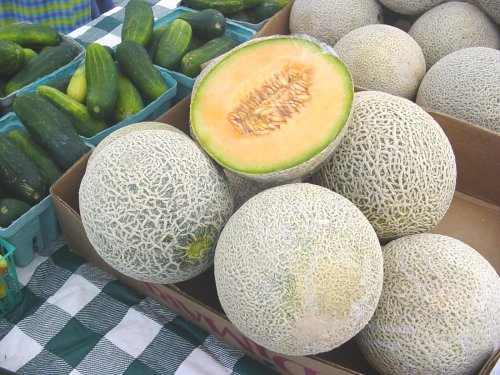
In the Philippines, honeydew melon is prevalent in Southern Luzon particularly in Mindoro Occidental where it’s one of the major products traded outside along with tuna, seaweeds, and precious stones.
One of the major problems of propagating the honeydew melon, aside from pest and diseases, is wet season production. Wet season is the off-season for producing honeydew melon. The excessive rain causes low yield and poor fruit quality resulting to great loss in production.
This scenario was the reason for the recent study conducted by Albino Aquino and Renato Mabesa of the Department of Horticulture, College of Agriculture, University of the Philippines Los Baños (UPLB). The main objective of the study is to find an effective and practical means to produce off-season honeydew melons using mulch and row cover.
This study was presented during the recently held National Research Symposium (NRS), an annual event organized by the Bureau of Agricultural Research (BAR) wherein top scientists and researchers from various state colleges and universities and premier research institutions gather to present the most promising researches and technologies developed and generated in the year. The paper won the AFMA Paper Award for the Published Category.
Mulching: Improving honeydew melon growth
Mulching is one of the simplest and most beneficial management practices that could improve the moisture and consistency of soil. As is it easy to do, mulching is inexpensive and does not require much effort. Mulching refers to the spreading of materials on the surface of the soil as protective layers, whether organic or inorganic, loose particles or sheets. Generally, mulching is used to protect the soil from erosion, reduce compaction from the impact of heavy rains, conserve moisture, reduce the need for frequent watering, maintain soil temperature, and prevent weed growth.
In this manner, mulching could improve off-season production of honeydew melon. Previous studies conducted involving other fruits showed that mulching could promote early plant development, increase yield, and enhance quality of produce.
Mulching materials
Mulching materials could be either organic or inorganic. Among some of the most common inorganic mulching and row cover materials are plastic. Studies showed that this type of mulching materials could modify the microclimate of plants and effectively improve plant growth. Likewise, the rise in air and soil temperature increases the flowers of watermelon.
For this particular study, three mulching materials were used: reflectorized polyethylene plastic (PEPrs), #50 black nonwomen fabric (NWFb), and rice straw. For the row covers, Aquino and Mabesa used 0.076 mm clear plyethylene (PEPc), #17 white woven fabric (NWFw), and white nylon net.
To determine the effectivity of the different mulch materials used, the researchers used five parameters: effect on microclimate, soil chemical properties, pest incidence, yield, and horticultural characteristics.
Ideal mulch and row cover
Results of the study showed that among the mulch materials used, polyethylene (PEP) proved to be the most advantageous and effective. Specifically, mulching with the reflectorized polyethylene plastic and clear polythylene (PEPc) and white nonwoven fabric (NWFw) as row cover increased the soil temperature and produced better nutrient uptake. There was also an increased in growth and flowering.
More female flowers matured earlier than expected. The insect and pest disease incidence were lesser. The fruit quality was better and the yield was higher compared to other melons under study.
Using the rice straw as mulch in combination with the non woven fabric as row cover also gave a favorable results but not as effective as the polyethylene.
Meanwhile mulching with rice straw alone resulted in highest arthropod pest infestation and diseases incidence due to the harboring of thrips and mites. It gained the highest air temperature and soil moisture retention, which are conditions suited for microbial growth. Nevertheless, using rice straw provided a few benefit. A notable increased in soil phosphorus, potassium and cation exchange capacity were observed after the cropping.
The use of nylon net as row cover allowed light to penetrate into the canopy thus resulting in the lowest air temperature due of its porus nature. Researchers concluded that nylon net is not as effective as the polyethelene or the nonwoven fabric as row covers.
—————————————–
Source:
Year-round production of small potted flowering Mussaenda through off-season production of flowering shoot by Primitivo Jose Santos, Calixto Protacio and Reynold Pimentel of the Institute of Plant Breeding, College of Agriculture (IPB-CA) in the University of the Philippines at Los Baños (UPLB)
By: Rita T. De la Cruz, BAR Digest, October-December 2003 Issue (Vol. 5 No. 4)


A meat grinder is a tool used to finely chop or grind food into smaller pieces, typically for use in cooking. There are many different types of grinders with various features and benefits.
Best Meat Grinders For Raw Dog Food: The best meat grinders for raw dog food are the ones that have the ability to crush bones and other tough parts of the animal while keeping the soft parts intact. This ensures that your dog gets all of their nutrients without any wasted food.
These are some of the best meat grinders for raw dog food. They are designed to be easy to clean and maintain.
The best meat grinder for raw dog food is a product that is meant to help you grind your pet’s food. These products are very easy to use and will make your life easier when it comes time for mealtime.
Thanks.